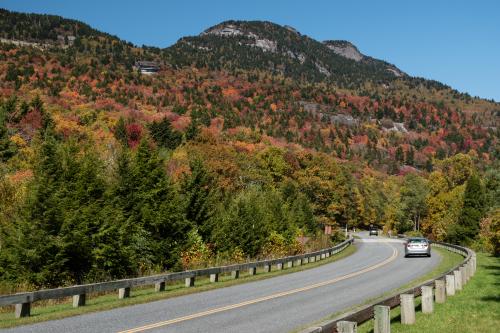Home of the Highest, Oldest Peaks
By Jack Igelman

Beyond Gorgeous Views Are Mountains Full of Life
The Cherokee called the mountain Tanawha, meaning Great Hawk or Eagle.
While that name may be forgotten, no other ridge top near Asheville is so familiar as the lofty silhouette of Grandfather Mountain, the name adopted by early settlers. At its high point, the craggy features of one of the area’s most famous peaks climb to nearly 6,000 feet in elevation.
Both names are fitting. According to Cherokee legend, a great bird formed the mountains. When his wings landed, valleys were created. And where they lifted, mountains swelled.
 Grandfather Mountain, or Tanawha, is just one of many soaring peaks scattered throughout the North Carolina mountains stretching from the Great Smoky Mountains National Park to the High Country.
Grandfather Mountain, or Tanawha, is just one of many soaring peaks scattered throughout the North Carolina mountains stretching from the Great Smoky Mountains National Park to the High Country.
“From Grandfather, you’re on the escarpment of the Appalachian Mountains, so you’re looking out 4,000 feet above the Piedmont,” said Grandfather Mountain executive director Jesse Pope. ”You feel like you’re on the top of the world.”
But the mountains here aren’t just the highest. They’re also the oldest.
Geologists claim that some of the rock formations on the massive mountain are more than a billion years old. And while the impressive mountain is ancient, the late Hugh Morton, guardian of Grandfather Mountain, never looked backwards. In 1952, he erected a 220-foot suspension bridge near its summit that was the bedrock for one of the region’s most beloved destinations. While the Morton family still owns the summit, the state took title to 2,456 acres of back country in 2008 to establish Grandfather Mountain State Park.
And like Grandfather Mountain, many of the high peaks surrounding Asheville are connected by the region’s premier scenic byway, the Blue Ridge Parkway (BRP).
Parkway public information officer Leesa Brandon says that although the motor route was originally designed as a scenic road in the 1930s, today there are many opportunities to get out of your car and explore.
“Asheville is a great springboard for a visit on the BRP. You can head north or south and have a completely different experience,” says Brandon.
 Travel northbound on the BRP from Asheville and visit Mount Mitchell State Park. At 6,684 feet, it rises above every other summit east of the Mississippi River. The park has a must-see museum open from May through October. Here, you can learn about the mountain’s natural and cultural history, including the effort by scholar Elisha Mitchell in the 1850s to prove the peak’s standing as the tallest.
Travel northbound on the BRP from Asheville and visit Mount Mitchell State Park. At 6,684 feet, it rises above every other summit east of the Mississippi River. The park has a must-see museum open from May through October. Here, you can learn about the mountain’s natural and cultural history, including the effort by scholar Elisha Mitchell in the 1850s to prove the peak’s standing as the tallest.
Unfortunately, a trip to the mountain in 1857 proved fatal and the scientist is laid to rest at the summit.
Indeed the highest, Mount Mitchell is just a hair taller than its sister summits along the chain of peaks known as the Black Mountains. In all, the lofty ridge includes six of the 10 highest peaks in the Eastern U.S.
To walk along the trail connecting them is an exploration through eons of ecological and geological forces contributing to an uncanny diversity of life. What may not be obvious at first glance, concealed below the lush green canopy of the Southern Appalachians is a staggering assortment of life unparalleled in North America outside of the tropics. Pope says that Grandfather Mountain is home to 70 endangered and rare species and its unique high elevation rocky outcrops harbor life found nowhere else on Earth.
And the altitude is what pushes the region’s ecological diversity to the next level. Stand at the apex one of North Carolina’s 52 summits exceeding 6,000 feet, including Mount Mitchell, where dark forests of northern spruce and fir trees are relics of the planet’s last ice age - about 11,000 years ago - when the cooling climate allowed northern plants and wildlife to head south.
And like Mount Mitchell, many of the region’s high peaks are protected by private enterprises, such as Grandfather Mountain, or within more than a million acres of public land in Western North Carolina. This includes half of the 522,000 acre Great Smoky Mountains National Park, state lands, and the 500,000+ acre Pisgah National Forest.
 The Pisgah National Forest, established in 1916 and the first in the East, takes it’s name from the 5,722 foot Mount Pisgah southwest of Asheville and perhaps the city’s most recognizable summit. Its distinctive conical apex is topped with a TV tower. According to legend, the Biblical name came from a visiting Presbyterian minister in 1776 who was perhaps lifted in awe by its sight.
The Pisgah National Forest, established in 1916 and the first in the East, takes it’s name from the 5,722 foot Mount Pisgah southwest of Asheville and perhaps the city’s most recognizable summit. Its distinctive conical apex is topped with a TV tower. According to legend, the Biblical name came from a visiting Presbyterian minister in 1776 who was perhaps lifted in awe by its sight.
A popular 1.5-mile trail to the summit from a parking area on the BRP is a fitting way to consider the history, culture and geology of the sky-high summits surrounding Asheville.
After all, for mountains that are eons old, there’s plenty to ponder. And, from a mile high, the views aren’t too shabby either.







